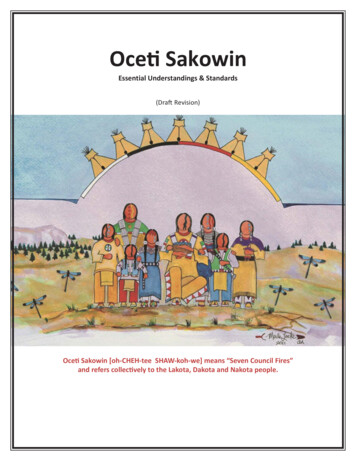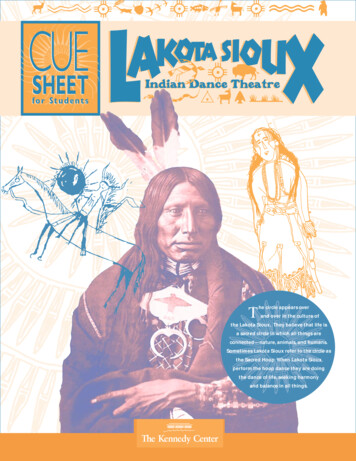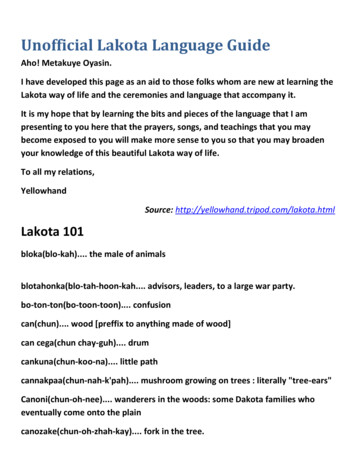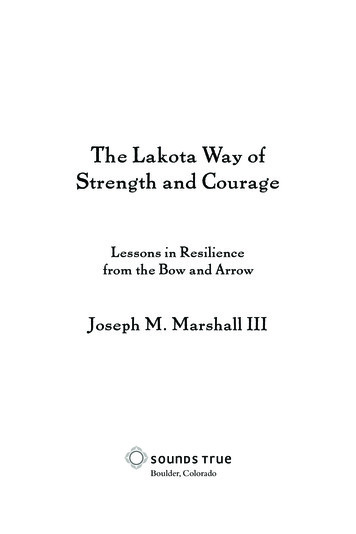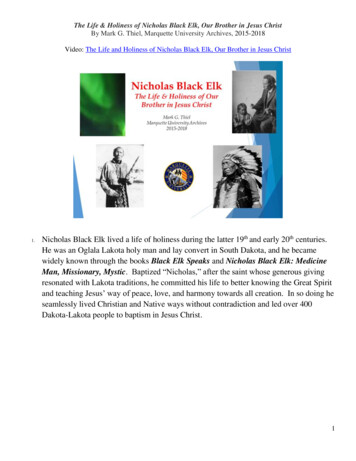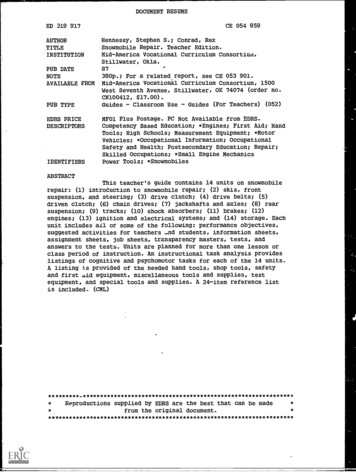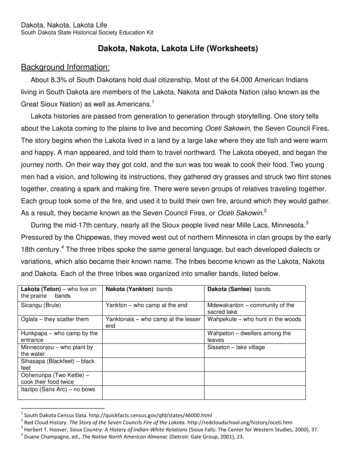
Transcription
Dakota, Nakota, Lakota LifeSouth Dakota State Historical Society Education KitDakota, Nakota, Lakota Life (Worksheets)Background Information:About 8.3% of South Dakotans hold dual citizenship. Most of the 64,000 American Indiansliving in South Dakota are members of the Lakota, Nakota and Dakota Nation (also known as theGreat Sioux Nation) as well as Americans.1Lakota histories are passed from generation to generation through storytelling. One story tellsabout the Lakota coming to the plains to live and becoming Oceti Sakowin, the Seven Council Fires.The story begins when the Lakota lived in a land by a large lake where they ate fish and were warmand happy. A man appeared, and told them to travel northward. The Lakota obeyed, and began thejourney north. On their way they got cold, and the sun was too weak to cook their food. Two youngmen had a vision, and following its instructions, they gathered dry grasses and struck two flint stonestogether, creating a spark and making fire. There were seven groups of relatives traveling together.Each group took some of the fire, and used it to build their own fire, around which they would gather.As a result, they became known as the Seven Council Fires, or Oceti Sakowin.2During the mid-17th century, nearly all the Sioux people lived near Mille Lacs, Minnesota.3Pressured by the Chippewas, they moved west out of northern Minnesota in clan groups by the early18th century.4 The three tribes spoke the same general language, but each developed dialects orvariations, which also became their known name. The tribes become known as the Lakota, Nakotaand Dakota. Each of the three tribes was organized into smaller bands, listed below.Lakota (Teton) – who live onthe prairie bandsNakota (Yankton) bandsDakota (Santee) bandsSicangu (Brule)Yankton – who camp at the endOglala – they scatter themYanktonais – who camp at the lesserendMdewakanton – community of thesacred lakeWahpekute – who hunt in the woodsHunkpapa – who camp by theentranceMinneconjou – who plant bythe waterSihasapa (Blackfeet) – blackfeetOohenunpa (Two Kettle) –cook their food twiceItazipo (Sans Arc) – no bows1Wahpeton – dwellers among theleavesSisseton – lake villageSouth Dakota Census Data. Red Cloud History. The Story of the Seven Councils Fire of the Lakota. t T. Hoover, Sioux Country: A History of Indian-White Relations (Sioux Falls: The Center for Western Studies, 2000), 37.4Duane Champagne, ed., The Native North American Almanac (Detroit: Gale Group, 2001), 23.2
Dakota, Nakota, Lakota LifeSouth Dakota State Historical Society Education KitLakotaOne of the earlier clans to leave Minnesota was the Lakota, including the Teton band. They settledin the Sioux and James River valleys during the 18th century, then pushed west past the MissouriRiver. The Lakota creation story tells how they came to hunt the buffalo.The Great Spirit Skan made us with bones from Stone, bodies from Earth, and soulsfrom himself, Wind and Thunders. The gifts of Sun, Wisdom, Moon, and Revealer gaveus life. A council of the spirits named us Pte Oyate–Buffalo Nation—and told us to carefor the spirits. One day Spider sent Wolf to the Underworld to tell Tokahe that life wouldbe easier on the surface of the earth. Tokahe ignored the warnings of the holy manTatanka, and led the people up through Wind Cave. Life there was hard, so Tatankacame to help—as a great shaggy beast. Since then the people have lived here with thebuffalo.5Every Lakota person has many relatives. All of them are part of his/her tiyospaye, the circle ofrelatives including mother, father, grandfather, grandmother, aunts, uncles, cousins and all relativesfrom marriage and adoption. When you know your relatives, you know where you come from and whoyou are. Kinship provides direction for daily living. All values and judgments of right and wrong relateto the duties and benefits of kinship. Each member of the group must act to insure the good of thetiyospaye.NakotaBy 1708, the Nakota, which included the Yankton band, had moved from their Minnesota home tothe northwestern corner of Iowa.6 By 1804, they had moved further west to the mouth of the JamesRiver where they met Lewis and Clark.7 By 1857, tensions rose between the Nakota and whitesettlers trespassing on tribal land. Chief Struck By The Ree went to Washington, DC, where he andother tribal leaders signed a treaty ceding the eastern half of South Dakota to the US government. 8The treaty relocated the Nakota from Yankton west to Wagner, SD.The Nakota never officially took up arms against the United States. They did sometimes fall victimto angry whites who punished them anyway, as did Fort Randall soldiers soon after the 1862Minnesota Uprising when they killed a Nakota hunting party that had legal permission to hunt in thearea.95South Dakota State Historical Society. Lakota Creation Story. http://travelsd.com/onlyinsd/sioux/Elmer Duane Cwach, “A History of the Yankton Indian Agency During the Nineteeth Century,” (MA Thesis, South Dakota StateUniversity, 1958), 1.7Harry H. Anderson, “The Diplomacy of Lewis and Clark among the Teton Sioux, 1804-1807,” South Dakota History 35, no. 1 (Spring2005), 41.8Hoover, Sioux Country, 53.9Cwach, “History of the Yankton Indian Agency,” 22.6
Dakota, Nakota, Lakota LifeSouth Dakota State Historical Society Education KitDakotaThe Dakota, or Santee, along with the Nakota formed the eastern Sioux tribes. Dakota means"Allies" or "Confederates," expressing their close ties with the Nakota and the Lakota, the westernSioux tribe. The Santee stayed in Minnesota until 1862, when they fought a desperate war with thewhites who were pushing them into smaller plots of land. After numerous treaties, they had so littleland left that they could not sustain themselves. The US government promised money and food forthe land, but the payments were so late the Santee were dying of starvation. The neglect worsenedafter the government became preoccupied with fighting the Civil War.10 After many years of starvationand disappointment, the Santee demanded help in feeding their families in 1862. Violence broke outand the Minnesota Uprising lasted about 40 days, taking hundreds of lives. Afterward, the whiteswanted revenge on the Santee, both guilty and innocent. Many Santee fled west to escape the angrywhites. Those who stayed in Minnesota were held responsible. About 1,700 Santee were capturedand put in prison and over three hundred were sentenced to hang. President Lincoln called for acareful review of the evidence, and the number hanged was reduced to thirty-eight.11 When thesentence was carried out on December 26, 1862, it was the largest mass execution in United Stateshistory.Forced Santee RelocationFollowing the Minnesota Uprising, 1,300 Santee were relocated to Crow Creek in Dakota Territory,near Fort Thompson. Special Agent Ben Thompson had chosen the site, just weeks before theSantee arrived, with a priority on isolation from white settlements. He defended his choice for years,saying it was suitable, but few would agree. The land was sparsely wooded, especially compared toMinnesota. Since hundreds of their able men had been sentenced to prison in Iowa, the new arrivalswere mostly women and children. They arrived already weakened and sick from crowded travel.Many had died along the way, and about 300 died from starvation, disease, and exposure the firstyear at Crow Creek.12While their women and children were shipped to Crow Creek, about two hundred Santee menwere sent to prison at Fort McClellen, Iowa. There many of the prisoners converted to Christianity andmixed freely with surrounding white neighbors, learning farming skills.13 By the spring of 1865, most10ndRoy W. Meyer, History of the Santee Sioux, 2 ed. (Lincoln, NE: University of Nebraska Press, 1993), 112.Champagne, Native American Almanac, 42.12Meyer, Santee Sioux, 146.13Paul Stuart, ed., Dacotah: A History of the Flandreau Santee Sioux (Flandreau, SD: Tribal History Program, Flandreau Sioux Tribe,1971), 53.11
Dakota, Nakota, Lakota LifeSouth Dakota State Historical Society Education Kitof the prisoners were returning north to Dakota in time to meet their families moving south from CrowCreek to a new reservation on the Niobrara River bordering Nebraska. Although some of the Santeeliked Niobrara, the government was years away from declaring it their permanent reservation. Thisuncertainty of a title to their home, in addition to a desire to live closer to the Minnesota borderprevented some of them from putting down roots.14 By the spring of 1869, twenty-five families leftNiobrara to establish a colony on the banks of the Big Sioux River. These families became theFlandreau Indian settlement, comprised mostly of heads of household who had learned white wayswhile imprisoned in Iowa.15Two other Dakota bands, the Sissetons and Wahpetons, though largely innocent of participating inthe Minnesota Uprising, had fled Minnesota and eventually settled the area west of Lake Traverseand Big Stone Lake by 1864. Fort Wadsworth, later renamed Fort Sisseton, was established neartheir settlement.16Traditional Village LifeOn the plains, the horse culture of the Lakota thrived. Life centered on the buffalo, which providedfood and shelter. Other foodstuffs included prairie turnips, chokecherries, other wild game, and fish.Trade with the earth lodge tribes along the upper Missouri River brought in corn, beans, and squash.The four seasons set the rhythm for village life. In the spring, women repaired or replaced tipis,and made clothing. They began gathering ripening berries and roots. For the men, spring brought thefirst buffalo hunts. It was also a time for repairing weapons, hunting other game, and hide painting.Socially, springtime meant dances sponsored by various tribal groups, and vision seeking. 17Summer brought more buffalo hunting to ensure the winter food supply. It was also a time forraiding parties to set out, and for trading with other tribes. Ceremonies such as the Sun Dance wereheld in the summer. Camp had to be moved every few days to follow the buffalo and reach newgrazing land for the horses. Tipis provided good easily moved shelter. The main components of thetipi were the poles, the hide cover, a liner, and anchoring stakes or stones. Women made and ownedthe tipis. A family of eight could live comfortably in a 14-foot tipi.To set up the tipi, three poles were tied together to form a tripod. Other poles were laid against thetripod to form a sturdy frame. The tipi’s hide cover, made from sewing buffalo hides into a semicircle,14Stuart, Dacotah, 63.Ibid., 71.16Meyer, Santee Sioux, 198.17Thomas E. Mails, The Mystic Warriors of the Plains (New York: Mallard Press, 1991), 25.15
Dakota, Nakota, Lakota LifeSouth Dakota State Historical Society Education Kitwas tied to the last post and pushed into place. Once spread over the poles, the cover was lacedtogether in front with wooden pins. The tipi cover was staked down or anchored with stones aroundthe edge to hold it in place. Smoke flaps on top of the tipi could be adjusted for ventilation andprotection from the rain. An interior liner was tied to the tipi poles. This provided privacy since whenthe central fire was lit, shadows would be cast on the liner and not on the outside tipi cover. Grassstuffed between the liner and the cover provided insulation. A tipi could be set up in 15 minutes.Inside the tipi, good order was essential. The door always faced east toward the rising sun.Generally, men’s places were on the north, and women’s on the south of the tipi. Personal belongingswere stored near an individual’s sleeping place. An altar was set up just behind the central fire pit tothe west, opposite the door. Firewood, food, and cooking utensils were kept near the door.Fall meant preparation for the coming winter. Food had to be gathered and buffalo meat dried.Wood had to be collected and stored. A fall hunt made sure the winter’s meat supply would beadequate.Life slowed down in winter camp, with less moving of camp from place to place. If enough foodhad been preserved and the area was secure, winter brought time for making and repairing clothingand doing intricate quill and beadwork. It was also a time for socializing, gambling, storytelling, andpassing on tribal oral history.18Lakota Reservation LifeWhile the Santee were being moved from Minnesota to Crow Creek to Niobrara, the Teton Lakotawere hunting buffalo in the country west of the Missouri River. The occasional white men who passedthrough their land were tolerated and useful trading partners. In 1866, the number of whites cominginto Lakota territory greatly increased on the Bozeman Trail to Montana’s gold mines. Less interestedin trading with the Indians, the travelers began to scatter and thin the buffalo. Fierce fighting againstthis incursion prompted the Fort Laramie Treaty of 1868, forming the Great Sioux Reservation thatincluded all of west-river South Dakota and halted travel along the Bozeman Trail.19 The treaty alsopromised the Black Hills would always be the Lakota’s hunting grounds.When gold was discovered in the Black Hills, the government could not hold back the miners.Buffalo hunters began a systematic killing of buffalo for their skins and tongue meat in 1871. 20 TheLakota and Cheyenne killed Custer and all his men at Custer’s Last Stand in 1876, but other soldiers18Mails, Mystic Warriors, 30.Hoover, Sioux Country, 57.20Champagne, Native American Almanac, 44.19
Dakota, Nakota, Lakota LifeSouth Dakota State Historical Society Education Kitretaliated severely. The railroads and buffalo hunters continued the buffalo killing and by 1885, themillions of buffalo that had roamed the plains were gone.In 1889, the Crook Commission signed an agreement with the Sioux opening the Great SiouxReservation to white settlement. The Sioux agreed to move onto reservations with specifiedboundaries.21 The Lakota were moved onto reservations at Pine Ridge and Rosebud. The huge shiftbetween a life of hunting buffalo and reservation life caused massive culture shock. Men used tohunting considered farming women’s work. The reservation land was too dry to farm anyway, somany stopped trying. Supplies promised by the government were late in coming, or short-changedby dishonest agents.22Dawes Act of 1887In 1887, the Dawes Act allotted reservation land to individual Indians rather than keeping itcommunal property owned by the tribe. The government hoped individual ownership would lead toless dependence on food rations and loosen tribal bonds. The lands not immediately allotted toIndians, were sold to white settlers, further reducing the Indian land base. The Indian landownersknew little about land management and often fell prey to whites who leased or bought the land for lowprices. To the government, these “landless Indians” represented a problem requiring more support asthe Indian land decreased in size.23 Some Indians thought the Dawes Act provided valuableexperience, although there were bound to be mistakes at first.24 However, most thought it was justanother way for the whites to grab their land. The Dawes Act was officially repealed with the IndianReorganization Act of 1934.Ghost Dance and Wounded KneeIt was during this discouraging period that the Sioux heard about the Ghost Dance. The newreligion promised that if they were faithful, the buffalo herds would come back, along with all theirdead relatives. If they danced the Ghost Dance, the whites would disappear and leave them again totheir old way of life.25 At Standing Rock, the influential medicine man Sitting Bull encouraged the newreligion among his people. The army moved to arrest Sitting Bull and stop his influence. He was killed21South Dakota State Historical Society, “Chronology of South Dakota History,” 1889. http://www.sdhistory.org/soc/soc hist.htmStephen D. Youngkin, “Prelude to Wounded Knee: The Military Point of View,” South Dakota History 4, no. 3 (Summer 1974): 333.23Richard Erdoes, Native Americans: The Sioux (New York: Sterling Publishing Company, Inc., 1982), 11.24Charles A. Eastman, From the Deep Woods to Civilization: Chapters in the Autobiography of an Indian (Boston: Little, Brown, andCompany, 1916), 168.25Erdoes, The Sioux, 20.22
Dakota, Nakota, Lakota LifeSouth Dakota State Historical Society Education Kiton December 10, 1890, while being arrested by tribal police.26 Word of Sitting Bull’s death grievedand angered the Lakota. Chief Big Foot and his followers fled the Cheyenne River area south towardthe Badlands. The band was captured by U.S. military troops and surrendered at Porcupine Creek.After surrendering, Big Foot’s band was taken to the small village of Wounded Knee. On December29, 1890, the soldiers prepared to search the group for weapons. In the confusion, a gun fired and thesoldiers began shooting with rifles and Hotchkiss guns. About 150 unarmed men, women, andchildren were killed.27 For the Lakota, Wounded Knee ended any hope of a return to the old life.MissionariesThe first known Christian missionary to meet the Sioux was Father Louis Hennepin, who livedamong them as a captive in 1680 in Minnesota. Hennepin learned their language and studied theirways. He told of a hunting, fishing, and wild rice-gathering people who cooked fish eggs in earthenpots.28After they moved onto the plains and during the reservation period, missionaries continued to workamong the Sioux. Missions were set up at Standing Rock, Cheyenne River, Pine Ridge, Rosebud,Lower Brule/Crow Creek, Yankton, Flandreau, and Sisseton. Missionary Stephen R. Riggs helpedpublish the first newspaper in the Dakota language called Iapi Oaye or Word Carrier. He learned theDakota language so well, that he published a dictionary and bible in it. 29 Several of his children andgrandchildren later served as missionaries and educators. Dr. Alfred Riggs founded the SanteeNormal Training School in 1870. Thomas Riggs started the Oahe Mission near Pierre in 1874.EducationThe Sioux needed to learn some of the white mans’ ways to survive in their changed world. By the1870s, mission boarding schools were being founded with the idea of bringing Indian people morefully into the white culture.30 Proponents of the schools hoped that young students would serve asmessengers of civilized ways to their parents. Homesick children were more interested inreintegrating themselves into family and tribal life than in promoting white ways.In 1879, Richard Henry Pratt started the first off-reservation boarding school, Carlisle Indian26SD Historical Society, “Chronology”, 1890.Ibid.28Meyer, Santee Sioux, 8.29Cwach, History of Yankton Agency, 30.30Dana Newmann, Plains Indians: A Complete Sourcebook for Teachers K-8 (West Nyack, New York: The Center for Applied Researchin Education, 1995), 115.27
Dakota, Nakota, Lakota LifeSouth Dakota State Historical Society Education KitSchool, in Carlisle, Pennsylvania.31 To counteract the tendency of the students to return to nativeways, they were given jobs with white farmers during the summer. Limited contact meant studentshad less influence from their families and native culture, and more from white culture. TheCarlisle School, with its total assimilation approach, was duplicated by schools nationwidebetween 1879 and 1902. In South Dakota, schools modeled on Carlisle opened in Pierre in 1890,Flandreau in 1893, and Chamberlain and Rapid City in 1898.32 Using total assimilation, schoolsforbade their students to speak native languages, and on the reservations holy ceremonies anddances were outlawed. The schools’ success rates varied. If the students were forced to attendand their parents did not support their attendance, students generally returned home to much thesame lifestyle they had before. Although few schools eradicated student ties to their nativeculture, they did succeed in teaching many students to read and write. Some off-reservationschools developed a more pragmatic approach with greater parental involvement and a gradualadaptation to white society and institutions.33 The boarding schools that still exist in South Dakotanow reinforce native culture and language.Recent TimesDuring the 1950s, Sioux families were induced to move from their reservations and attempt toassimilate further into the workplaces of the larger cities.34 Some tried, but with insufficient education,many struggled to find jobs. Others missed family ties and tribal culture and returned home to thefamiliarity of the reservation.Modern day frustrations of past injustices and reservation life spilled over on February 27, 1973,when a militant group called the American Indian Movement (AIM) occupied Wounded Knee. Forseventy-one days, AIM demanded that the government look into the many treaties it had neverfully honored. Newspapers, radio, and television provided national coverage of the siege. Withbloodshed and considerable bitterness on both sides, the 1973 Wounded Knee occupation stillcarries great symbolic significance. The suffering and mistreatment of American Indians receivedworldwide attention.3531Tsianina Lomawaima and Margaret L. Archuleta, eds., Away from Home: American Indian Boarding School Experiences 1879-2000(Phoenix, AZ: Heard Museum, 2000), 16.32David Wallace Adams, Education for Extinction: American Indians and the Boarding School Experience (Lawrence, KS: UniversityPress of Kansas, 1995), 57.33Ibid., 299.34thSouth Dakota State Historical Society exhibit, Changing Times: South Dakota in the 20 Century, 2006.35Rolland Dewing, “South Dakota Newspaper Coverage of the 1973 Occupation of Wounded Knee,” South Dakota History 12, no. 1(Spring 1982): 48.
Dakota, Nakota, Lakota LifeSouth Dakota State Historical Society Education KitLakota, Nakota and Dakota culture and language are very much alive today. Grants providefunding and opportunities to document the language and interview elders.36 Once prohibited fromworshipping as they chose, Dakota, Nakota and Lakota people can now attend sweatceremonies and Sun Dances. Powwows are enjoyed in many communities.Problems on the reservations are acute. Lack of clean water, good highways, and investmentcapital impede progress in Indian Country. Health problems are made worse by severe povertyand overcrowded living conditions. Tuberculosis used to be the major health concern but todayalcoholism and diabetes are more serious. Other big health concerns are mental illness,accidents, suicides, and homicides.37Casino gaming has brought some much needed financial gains to the reservations, but gamblingalone cannot meet all the financial needs. By 2006, eight out of nine South Dakota tribes rangambling operations. Tribal officials report 1,700 casino jobs with a thirty million dollar annualpayroll.38ConclusionLakota, Nakota and Dakota people work, play, raise their families and contribute to the growth anddevelopment of communities throughout South Dakota and the nation. As with all people, individualsdecide what combination of the traditional and the modern will shape their lives in the 20 th century.Family, tribal, and cultural ties and the proud history of Oceti Sakowin provide a solid basis fortackling the financial, social and health problems that exist in Indian country.Teacher Resource Paper Bibliography 36Adams, David Wallace. Education for Extinction: American Indians and the Boarding School Experience. Lawrence, KS: University Press ofKansas, 1995.Anderson, Harry H. “The Diplomacy of Lewis and Clark among the Teton Sioux, 1804 1807.” South Dakota History 35, no. 1 (Spring 2005).Brokaw, Chet. “S.D. Legislature Wants Say in Gaming Agreements.” Indian Country Today, February 28, 2006.http://wwwindiancountry.com/content.cfm?id 1096412561.Champagne, Duane, ed. The Native North American Almanac. Detroit: Gale Group, 2001.thCultural Heritage Center. Changing Times: South Dakota in the 20 Century Exhibit. Pierre, SD. 2006.Cwach, Elmer Duane. “A History of the Yankton Indian Agency During the Nineteenth Century.” MA thesis, South Dakota State University, 1958.Dewing, Rolland. “South Dakota Newspaper Coverage of the 1973 Occupation of Wounded Knee.” South Dakota History 12, no. 1 (Spring 1982).Eastman, Charles A. From the Deep Woods to Civilization: Chapters in the Autobiography of an Indian. Boston: Little, Brown and Company, 1916.Erdoes, Richard. Native Americans: The Sioux. New York: Sterling Publishing Company, Inc.,1982.Hoover, Herbert T. Sioux Country: A History of Indian-White Relations. Sioux Falls: The Center for Western Studies, 2000.Lomawaima, K. Tsianina and Margaret Archuleta, eds. Away from Home: American Indian Boarding School Experiences 1879-2000. Phoenix:Heard Museum, 2000.Mails, Thomas E. The Mystic Warriors of the Plains. New York: Mallard Press, 1991.Meyer, Roy W. History of the Santee Sioux. 2nd ed. Lincoln, NE: University of Nebraska Press, 1993.Albert White Hat, Native American Awareness Training session, Pierre, SD, November 15, 2005.Champagne, Native American Almanac, 77.38Chet Brokaw, “S.D. Legislature Wants Say in Gaming Agreements,” Indian Country Today, February 28, 2006.http://www.indiancountry.com/content.cfm?id 1096412561.37
Dakota, Nakota, Lakota LifeSouth Dakota State Historical Society Education Kit Newmann, Dana. Plains Indians: A Complete Sourcebook for Teachers K-8. West Nyack, NY: The Center for Applied Research in Education, 1995.Red Cloud History. “The Story of the Seven Council Fires of the Lakota”. http://redcloudschool.org/history/oceti.htmSouth Dakota State Historical Society. “Lakota Creation Story”. http://travelsd.com/onlyinsd/sioux/“Chronology of South Dakota History.” http://www.sdhistory.org/soc/soc hist.htmStuart, Paul, ed. Dacotah: A History of the Flandreau Santee Sioux. Flandreau, SD: Tribal History Program Flandreau Sioux Tribe, 1971.United States Census Bureau. hite Hat, Albert. Native American Awareness Training. Pierre, SD, November 15, 2005.Youngkin, Stephen D. “Prelude to Wounded Knee: The Military Point of View.” South Dakota History 4, no. 3 (Summer 1974).
Dakota, Nakota, Lakota LifeSouth Dakota State Historical Society Education KitNameWord IERTHANYUTHOUTZTiyospayeCrow CreekPine RidgeWounded KneeDakotaGhost DanceBuffalo sebudLakotaFlandreau
Dakota, Nakota, Lakota LifeSouth Dakota State Historical Society Education KitWord Find KeyTiyospayeCrow CreekPine RidgeWounded KneeDakotaGhost DanceBuffalo sebudLakotaFlandreau
Dakota, Nakota, Lakota LifeSouth Dakota State Historical Society Education KitNameCrossword PuzzleWord List:Buffalo Treaty Tipi Pemmican Beads Quilling Sioux Drum Horse Dialects5Across1. groups play at powwows today.2. Lakota, Nakota, and Dakota are language as well as tribal names.3. is a mixture of buffalo fat and berries that will keep for a long time.4. Tatanka or provided food and shelter.Down5. Clothes could be decorated by , using the dyed hairs from a porcupine.6. White traders brought glass which were used as decorations.7. A could be set up in 15 minutes and provided good shelter.8. The Great Reservation included all of western South Dakota.9. An agreement between a tribe and the government was called a .10. A pulled the travois with the family’s belongings on it when camp wasmoved.
Dakota, Nakota, Lakota LifeSouth Dakota State Historical Society Education KitCrossword Puzzle Key51 D23PD67BEADSTIPIMMICRAAQU MIL ELINGC4TB89SIOUXTREATYFF10LHORSEAcross1. groups play at powwows today.2. Lakota, Nakota, and Dakota are language as well as tribal names.3. is a mixture of buffalo fat and berries that will keep for a long time.4. Tatanka or provided food and shelter.Down5. Clothes could be decorated by , using the dyed hairs from a porcupine.6. White traders brought glass which were used as decorations.7. A could be set up in 15 minutes and provided good shelter.8. The Great Reservation included all of western South Dakota.9. An agreement between a tribe and the government was called a .10. A pulled the travois with the family’s belongings on it when camp wasmoved.
Dakota, Nakota, Lakota LifeSouth Dakota State Historical Society Education KitNameReservation ScrambleWord ListFlandreau Pine Ridge Santee Lower Brule Rosebud SissetonStanding RockYankton1. This reservation includes the South Dakota towns of Eagle Butte and Wakpala, but it also extendsinto North Dakota.GNITSNADCORK22. Many Lakota speaking Sioux live on this western South Dakota reservation. N I P E I D E G R63. Some Santee Sioux broke away from the Niobrara reservation to form this eastern South Dakota colony ofhomesteaders.NALAUDFER74. This reservation is located in central South Dakota, near Fort Thompson. O W L E R9ULREB5. This south-central South Dakota reservation includes the towns of Mission and St. Francis. E B O D S R U46. This northeastern South Dakota town is part of the Lake Traverse reservation which extends into NorthDakota.ISSONETS17. This reservation in southeastern South Dakota has the same name as a nearby town. N N T Y O K A3&88. The reservation is in northern Nebraska.ESNTAE5Fill in the letters from the numbered spaces above to find the answer below.9. The extended family group in Lakota is called
living in South Dakota are members of the Lakota, Nakota and Dakota Nation (also known as the Great Sioux Nation) as well as Americans.1 Lakota histories are passed from generation to generation through storytelling. One story tells about the Lakota coming to the plains to
